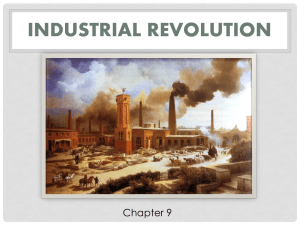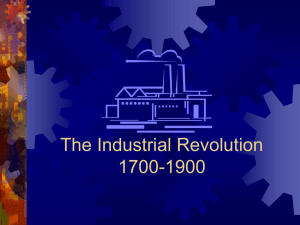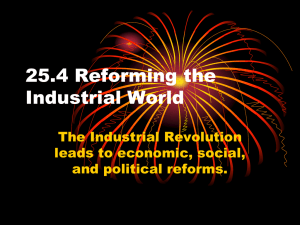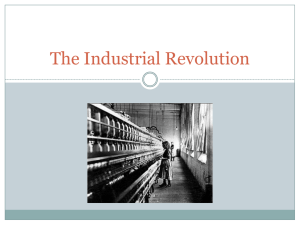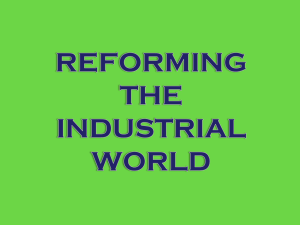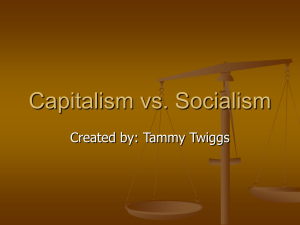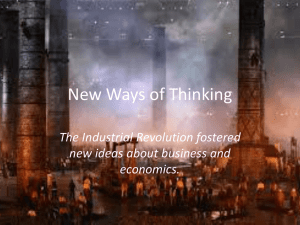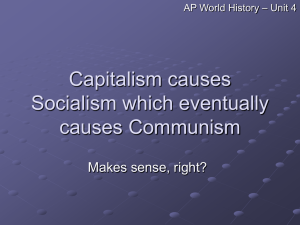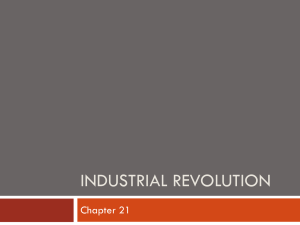The Beginnings of Industrialization
advertisement
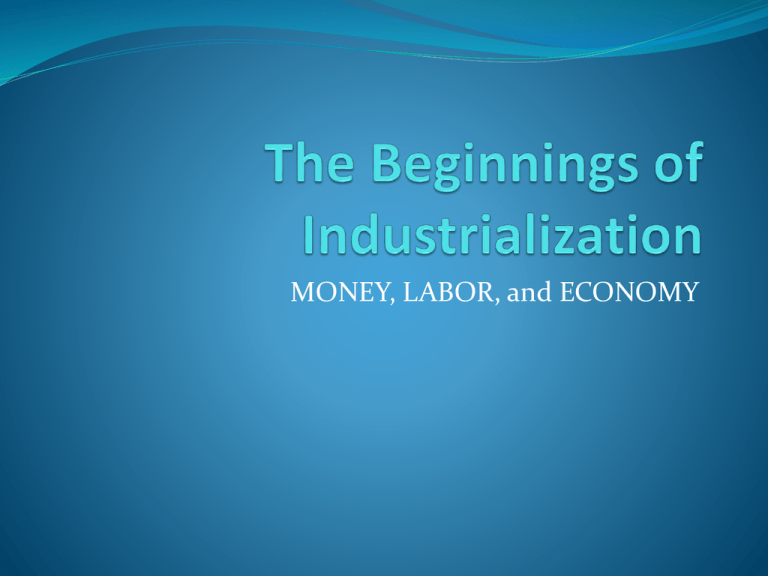
MONEY, LABOR, and ECONOMY Objectives (sec 1) Explain the origins of the Industrial Revolution. (sec 1) Explain the impact of mechanization (machines). (sec 2) Describe the social and economic effects of industrialization. (sec 3) Explain the impact on land, labor and corporations. (sec 4) Explain the reaction to industrial capitalism. (sec 4) Explain the origins and main concepts of capitalism, socialism, and communism. Questions to Consider What were four factors that contributed to industrialization in Britain? How did rising population help the Industrial Revolution? What American invention aided the textile industry? Was the revolution in agriculture necessary for the Industrial Revolution? What effect did entrepreneurs have on the Industrial Revolution? The Industrial Revolution Begins in Britain Agriculture paves the way for more food More food=more people (workers) Enclosures (fields) Crop-rotation (better soil/yield) Experimentation in farming Smaller farmers were leaving to cities (workers) Why the Revolution Began In England Large population Natural resources Water and coal power Iron ore for machines Rivers/Harbors Why the Revolution Began In England They also had the Factors of Production: Land Labor Capital ($$) Changes in the Textile Industry Several inventions were made to increase textile (cloth) production Flying Shuttle Spinning Jenny Water Frame Spinning Mule Power Loom http://video.google.com/ videoplay?docid=7833539046121151628# A power loom at work… Changes in the Textile Industry In America, things were changing too Eli Whitney invented the Cotton Gin Easier to separate cotton from boll Increased demand for cotton in US and Britain Increased demand for slave labor in US Improvements in Transportation Steam Engine-James Watt (with help of entrepreneur or investor) Steamboat-Robert Fulton Better paved roads-John Mc Adam Trains and Boats Questions to Consider What were four factors that contributed to industrialization in Britain? How did rising population help the Industrial Revolution? What American invention aided the textile industry? Was the revolution in agriculture necessary for the Industrial Revolution? What effect did entrepreneurs have on the Industrial Revolution? Section 2-Industrialization Objective: Describe the social and economic effects of industrialization. Size of Cities Growth of factories, bringing job seekers Urban areas doubling, tripling, or quadrupling in size Factories developing near new sources of energy Many new cities specializing in certain industries Living Conditions in Cities No sanitary codes or building controls Lack of housing, education, and police No running water or indoor plumbing Frequent epidemics sweeping through slums Tenement Life Jacob Riis-Tenement Life Leisure Time Lewis Hine Lewis Hine Lewis Hine Working conditions IR creating new jobs Harsh and severe Workers trying to keep discipline Eventually shorter hours, higher wages and better conditions pace w/machines Factories dirty and unsanitary Running dangerous machines long hours in unsafe conditions Emerging social classes Growing middle class of factory owners, shippers and merchants Upper class of landowners and aristocrats resentful of middle class Lower middle class of factory overseers and skilled workers Overworked and underpaid Positive effects of Industrial Revolution (Eventually) More jobs Contributed to wealth and power of nation (who specifically?) Healthier diets Better housing Cheaper, mass-produced items Eventually there were labor gains made: shorter hours higher wages better working conditions Section 2-Industrialization Objective: Describe the social and economic effects of industrialization. Section 4-Reforming the Economic World Objectives (sec 4) Explain the origins and main concepts of capitalism, socialism, and communism. (sec 4) Explain the reaction to industrial capitalism. Questions to Consider What were Adam Smith’s three natural laws of economics? What kind of society did early socialists want? What were Karl Marx’s key ideas? Why did workers join together to form unions? Why did the labor reform movement spread to other areas of life? Effects of Industrialization As industry grew, so did wealth. Philosophers started looking at how wealth and labor affected society. Some believed government should have a role in business, others did not. Capitalism Laissez faire (let do) “The Invisible Hand” that guides the market. privately owned industry and businesses would set standards for working conditions favors free market economy unregulated by government Capitalism Economy is based on supply and demand High supply=low prices Low supply=high prices High demand=high prices Low demand=low prices Government would screw this up (ability to make $$$) Capitalism -Adam Smith-1776 book “The Wealth of Nations" detailed that economic liberty guaranteed economic progress for everyone Three laws: Law of self interest (people act in their own interest) Law of competition (forces people to make a better product) Law of supply and demand (enough goods would be produced to meet society’s demands) Socialism (roots) Other philosophers felt that government should intervene in business They saw the low wages of the lower class, the poor living and working conditions, and uncaring business owners as a problem for society. Socialism (Utilitarianism) An early form of socialism was Utilitarianism. Jeremy Bentham’s idea was that people should judge institutions, ideas, and actions based on their usefulness. Government should promote programs that would benefit the greatest amount of people. Bentham’s Head Socialism (Utilitarianism) John Stuart Mill Felt that it was wrong that workers lived hard lives Wanted to create policies that would lead to more equal division of profits Wanted to reform women’s rights, voting rights, and prison reform Socialism Took Utilitarianism one step further Charles Fourier and Saint-Simon wanted to offset the negative aspects of industrialization They created philosophy of socialism Socialism Socialism is when the factors of production (Land, Labor, and Capital) are controlled by the public (government) and industry is run and controlled for the benefit of all people in the society. Government control of factories, railroads, raw materials, and other key industries would end poverty and poor working conditions brought on by the quest for profit (by private owners of industry). What is Socialism? Marxism (Radical Socialism) AKA= Communism Outlined in Karl Marx and Friederich Engels’ pamphlet The Communist Manifesto Marxism (Radical Socialism) Society has always been divided into warring classes: The “Haves” or bourgeoisie (wealthy) And The “Have-nots” or proletariat (working class) Marxism (Radical Socialism) The wealthy controlled means (L, L, C) of producing goods The poor did the backbreaking labor of actually producing the goods (in terrible conditions). The Industrial Revolution made the rich richer and the poor poorer. “The proletarians have nothing to lose but their chains. They have a world to win. Working men of all countries, unite.” From the Communist Manifesto Marxism (Radical Socialism) World View: 1. 2. 3. 4. 5. Large industries would crush smaller artisans and control all of the wealth Large proletariat would revolt and seize control of industry and produce what was needed for society Workers would share profits and bring economic equality for all people Workers would control government/economy in a “dictatorship of the proletariat.” A classless society would develop over time Marxism (Radical Socialism) This was pure communism, or radical socialism All means of productions are controlled by people Private property would cease to exist All goods and services would be shared equally Marxism (Radical Socialism) Marx and Engels felt that economics alone controlled society History has shown that religion, nationalism, ethnic loyalties and a desire for democratic reforms may be as strong of influences as economics are Also, the gap between the rich and poor closed over time Democratic Reforms Faced with tough working conditions, workers formed unions These were organizations that bargained for better working conditions, wages, benefits, etc. If the owners of industry would not negotiate, the workers would stop working (strike) Democratic Reforms Factory Act of 1833> Illegal to hire children under 9 years old. 9-12 year olds could only work 8 hours a day 13-17 year olds could only work 12 hours Women and children couldn’t work underground (mines) This spirit spread to other areas: Slavery Women’s rights Education Prisons Questions to Consider What were Adam Smith’s three natural laws of economics? What kind of society did early socialists want? What were Karl Marx’s key ideas? Why did workers join together to form unions? Why did the labor reform movement spread to other areas of life?
